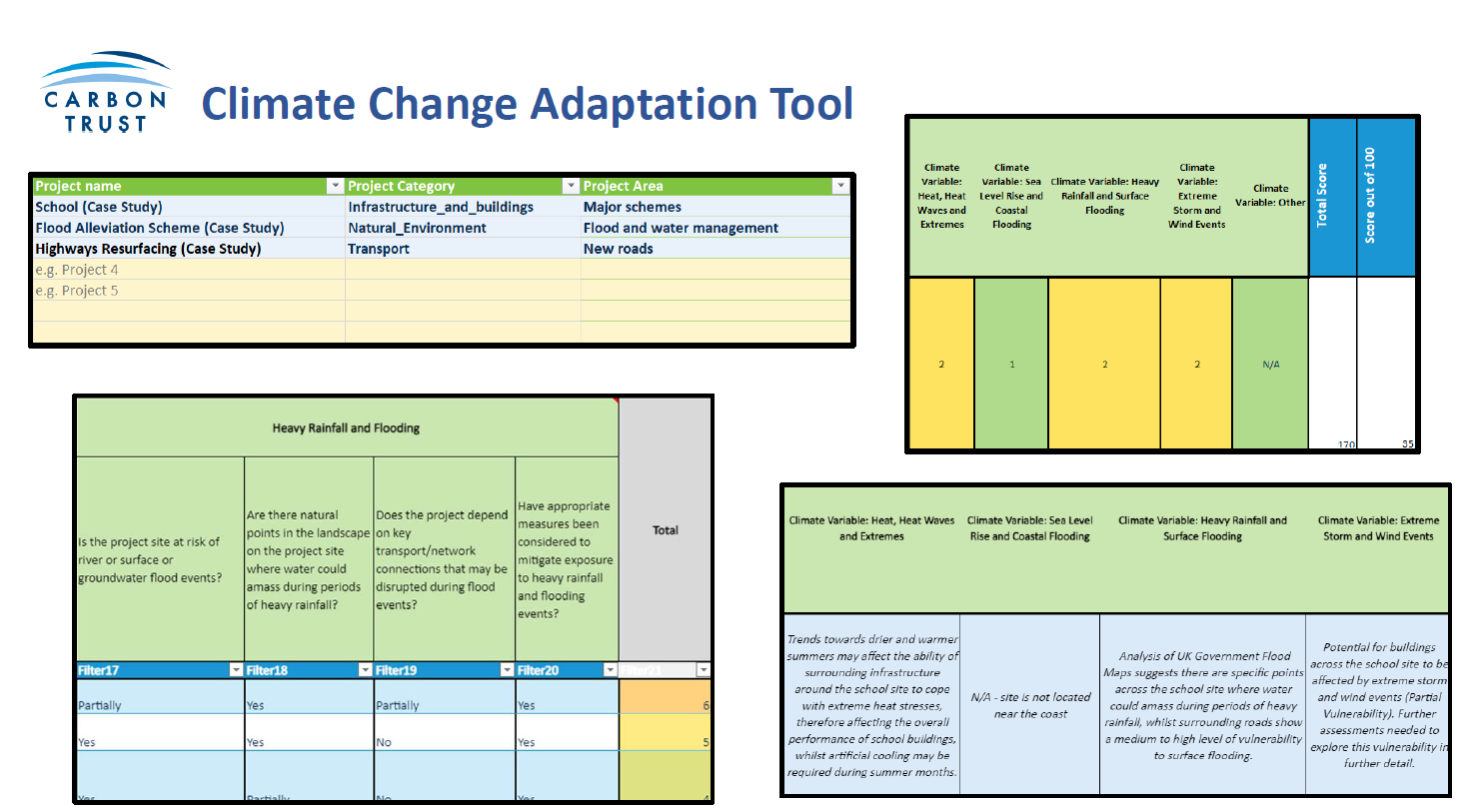20 Sep 2024
How is Action 11 tackling the climate crisis?
Some climate impacts, like flooding, intense heat and water shortages, are already inevitable, and often it’s the people least responsible for climate emissions that are most vulnerable to these impacts.
The changing climate means that Hampshire, along with the rest of southern England, is predicted to have hotter, drier summers, with a 20-60% reduction in summer rainfall. Some neighbourhoods are more vulnerable to overheating and its effects than others, for example those with a high number of older people and children, those without green space to shelter from the heat, and those where the type of housing is most susceptible to overheating. Within Hampshire there are more than 20 neighbourhoods that are particularly vulnerable to extreme heat, including 7 in Rushmoor and 5 in Test Valley. In addition, sea level rise of 30 cm by 2040 and increased winter rainfall (of up to 35% by 2080) will contribute to more frequent and severe flooding events – Winchester has been hit by multiple flooding events in recent years.
The Climate Change Committee has warned that adaptation measures are falling behind the pace at which climate risks are worsening. Adaptation isn’t well covered by council climate action plans, and implementing resilience measures isn’t a statutory function of local authorities.
Hampshire County Council is one of the local authorities that is acting – it’s taking a holistic approach to adapting and building resilience to the worsening impacts of climate change across the county. It’s even set a specific target – alongside its target for carbon neutrality – to build resilience to the impacts of a 2°C rise in temperature. Hampshire County Council is currently the only local authority in the UK to set resilience targets.
The local authority’s overriding ambition is to embed climate resilience into the DNA of the council and its work, and it’s delivering this through incorporating resilience considerations into general decision making. The council worked with the Carbon Trust to create 2 decision-making tools for adaption and mitigation, offering a robust method for assessing the vulnerability of new council projects to climate change impacts such as heatwaves or flooding.
This now represents part of the council’s mandatory decision-making process, meaning that all council staff must use both tools to explain how projects will either reduce emissions or boost resilience to future climate change impacts. Both tools are designed to be used in Microsoft Excel and don’t require an environmental background, making the process accessible to all staff members.
Click on the image to view a PDF version of the tool.
In addition, the council has announced that 2022 is its “Year of Climate Resilience”. This includes an array of projects being implemented across key strands:
Better planning
- Designing more energy-efficient housing and streets with better shading to reduce overheating.
- Developing river catchment plans in collaboration with the community – prioritising the areas within each catchment that are most at risk of flooding in order to build greater resilience to this threat moving forward.
Better management of built and natural environments
- Flood alleviation schemes, such as highway drainage systems that are designed to reduce the flood risk to transport while also boosting biodiversity alongside roadways.
- A rewilding programme – planting trees on council land and sites such as public highways, as well as working with local planning authorities to increase the requirement for planting on new developments.
What impact has the project had?
Hampshire County Council officers conducted a survey of staff members from across different departments to determine the success of the new climate change decision tools. The results included:
- 67% stating that the process of completing a climate change impact assessment (for which the adaptation tool was used) increased their awareness of climate adaptation and resilience.
- 58% saying that the adaptation tool will influence decision making for current and future projects based on climate considerations.
Results of using the tools are also beginning to show. For example, measures to mitigate the risk of extreme heat have now been included in the designs of a new school building and an infrastructure project for the first time. Local authority officers are now also considering climate impacts on health, such as how volunteers working on council projects may cope in times of sustained hot weather and how enhancing shade covering could mitigate against this.
The tools are also aiding staff to identify the wider impacts of flood events and the importance of designing road drainage systems. These measures will reduce the risk to people and property, as well as identify how significant flooding can interrupt the delivery of council programmes.
Hampshire is beginning to work with the Environment Agency to look at property-level adaptation and improve the resilience of individual homes, with previous flood events being used to help target the most vulnerable residents.
What made this work?
Collaboration and partnership working
Hampshire’s approach to resilience and adaptation is built on partnership working at all levels, both internally across council departments and externally across community groups, public bodies, education providers and others.
At a local authority level, this includes the Hampshire Climate Change Officers Group, where knowledge and best practice on mitigation and resilience is shared. The council has also worked closely with neighbouring district and borough councils to further embed resilience regionally – this has included sharing the decision tool with Winchester City Council and supporting it to incorporate the tool into its programmes.
Hampshire County Council has also partnered with local charity the Environment Centre to provide a free phone advice line on behalf of the council. In addition to providing energy efficiency tips, this service offers advice to locals on how to improve domestic resilience to climate change impacts – such as adding insulation to their property in ways that can reduce overheating, or making driveways more permeable. Community groups including The Greening Campaign and Community Energy South also support the council to share knowledge and practical measures to improve resilience at a local level.
Communication
The council has been raising awareness with its residents – outlining 2022 as the “Year of Climate Resilience” and supporting the implementation of new resilience measures through animation videos and resident-focused social media campaigns. The campaign has been delivered in stages, timed to relevant seasonal events, such as heatwaves and flooding. It's targeted 40–60-year-olds on actions they can take in their homes to adapt to the changing climate, which can help residents to be more comfortable and make cost savings.
Engaging and working closely with local stakeholders
Hampshire County Council has created a Climate Change Expert Stakeholder forum that meets 4 times a year to discuss the local authority’s progress towards its climate commitments, including resilience measures. The forum consists of representatives of local universities, private companies – such as utilities services provider SSE – and local community groups, including Friends of the Earth groups.
The council’s draft Catchment Management Plans also underwent a 6-week public consultation with local people, community groups and government bodies. These plans set out Hampshire’s key priorities and principles for managing flood risk.
What resources were needed?
The development of the decision-making tools with the Carbon Trust was paid for as part of a £2 million pot of one-off funding secured when Hampshire County Council declared a climate emergency.
In terms of broader programmes, developing measures that boost adaptation and improve resilience locally is more expensive, but the cost of inaction long-term would also create financial pressure on the council’s budget.
Lessons from Hampshire
Overcoming cost barriers
For many infrastructure capital projects that are important to improving local resilience, finance is a key barrier.
Climate-resilient infrastructure may cost more than infrastructure that hasn’t been designed for future climate breakdown. However, the cost of building infrastructure that isn’t designed to withstand future changes will be substantial, both through direct council costs such as repairing damaged roads, and through social, health and economic impacts caused by events such as flooding.
Moving forward, existing budgets across council departments will need to be reworked to take into account improved resilience. This’ll require council-wide buy-in to integrate this more broadly – introducing decision-making tools that factor in resilience is an important first step.
Supporting the community
If a local authority is unable to fund major schemes, resilience improvements can still be delivered at a property level by engaging and empowering community groups and local people to make a difference individually. Hampshire has created guidance for local residents to improve their resilience to climate impacts, and is actively working with The Greening Campaign to raise awareness of this more broadly in the community.
Even with measures to improve resilience being implemented, some impacts from the climate crisis will still be felt. Local authorities should consider how best to support those most vulnerable in the community to be better prepared for climate change impacts. Hampshire’s guidance includes advice on where to get flood warnings and where to get protection such as sandbags. Hampshire County Council is also working in partnership with iChoosr to deliver the Solar Together scheme, which enables residents to purchase solar panels as part of a group-buying scheme at a competitive price.
Friends of the Earth's view
Hampshire County Council is leading the way by setting a target for resilience and putting a strong emphasis on adaptation in its climate action plan.
It’s vital that efforts to make places more resilient to the impacts of climate change target the people that are most vulnerable to impacts like overheating and flooding. Ensuring that these communities are supported will be a key test for the work that Hampshire is doing.
For all county councils acting on adaptation, it'll be key to get good collaboration from district councils as well as other stakeholders to deliver the changes that are needed.
To scale up action on adaptation, councils will need better resourcing from national government and the development of transparent and free-to-use tools – it doesn’t make sense for every council to have to fund the cost Hampshire had to pay.
Friends of the Earth is showcasing specific examples of good practice in tackling climate change, but that doesn’t mean we endorse everything a council is doing.
This case study was produced by Ashden and Friends of the Earth. Any references to national policy in this case study relate to policy under the previous government and reflect the policy context in which the council was operating at the time.






